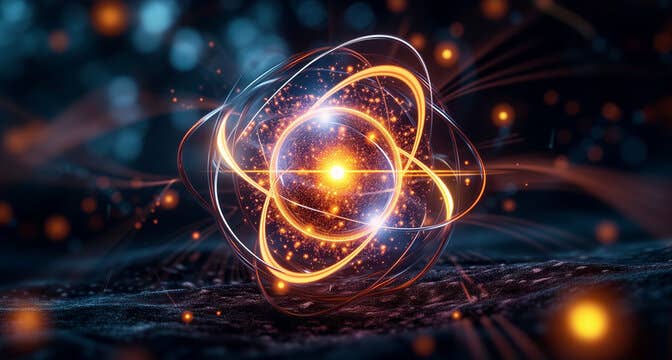Nucleon breakthroughs: Unifying models and discovering exotic antimatter nuclei
Nucleons, the particles that make up the nucleus of an atom, are fundamental to understanding the universe’s building blocks. Recent scientific breakthroughs have shed new light on these particles, offering…

Recent discoveries in nucleon research have unified atomic models and unveiled exotic antimatter nuclei. (CREDIT: Adobe Stock)
Nucleons, the particles that make up the nucleus of an atom, are fundamental to understanding the universe's building blocks. Recent scientific breakthroughs have shed new light on these particles, offering insights that could revolutionize various fields, from medicine to energy production.
Nucleons are the collective term for protons and neutrons, the components of an atom's nucleus. Protons carry a positive charge, while neutrons are neutral. Together, they account for nearly all the mass of an atom. The behavior and interactions of nucleons are governed by the strong nuclear force, one of the four fundamental forces of nature.
Recent advancements in nucleon research have significantly deepened our understanding of atomic nuclei, leading to potential applications in various scientific and technological fields. Below is an in-depth exploration of three pivotal studies:
Unifying Models of Atomic Nuclei
For decades, physicists have employed two distinct models to describe atomic nuclei:
- Nucleon-Based Model: This model focuses on protons and neutrons as the primary constituents of the nucleus, effectively explaining nuclear behavior at low energy levels.
- Quark-Gluon Model: At higher energy scales, protons and neutrons themselves are understood to be composed of quarks held together by gluons.
In October 2024, researchers from the Institute of Nuclear Physics of the Polish Academy of Sciences, in collaboration with the international nCTEQ group, achieved a significant breakthrough by integrating these two models. They developed a unified framework that describes atomic nuclei across varying energy levels.
Related Stories
This was accomplished by enhancing parton distribution functions (PDFs), which map the distribution of quarks and gluons within protons and neutrons. By incorporating the phenomenon of nucleon pairing—where protons and neutrons form strongly interacting pairs—the researchers provided a more comprehensive understanding of nuclear structure.
Dr. Aleksander Kusina, a physicist at the Institute, stated, "In our work, we have managed to bring these two so far separated worlds together."
This unified model offers a coherent picture of atomic nuclei, enhancing our understanding of nuclear reactions and potentially informing advancements in nuclear energy and medical imaging technologies.
Discovery of Antihyperhydrogen-4
In August 2024, scientists at the Brookhaven National Laboratory's Relativistic Heavy Ion Collider (RHIC) made a groundbreaking discovery: the heaviest antimatter nucleus ever detected, known as antihyperhydrogen-4. This exotic nucleus comprises an antiproton, two antineutrons, and an antilambda particle.
The discovery was made by analyzing data from six billion collisions of atomic nuclei, where approximately 16 instances of antihyperhydrogen-4 were identified. This finding provides valuable data for understanding the matter-antimatter asymmetry in the universe, potentially informing future research in particle physics and cosmology.
Junlin Wu, a graduate student at Lanzhou University and the Institute of Modern Physics in China, explained, "Our physics knowledge about matter and antimatter is that, except for having opposite electric charges, antimatter has the same properties as matter—same mass, same lifetime before decaying, and same interactions."
This discovery not only confirms existing theories about antimatter but also opens new avenues for exploring why our universe is predominantly composed of matter.
Advancements in Machine Learning for Nuclear Physics
In February 2024, researchers at Argonne National Laboratory applied machine learning techniques to study the excited states of sulfur-38, a neutron-rich isotope. By analyzing data from nuclear reactions, they identified unique quantum energy levels, or "fingerprints," of sulfur-38. This approach offers a sensitive test of the strong nuclear force that binds protons and neutrons together.
The study, published in Physical Review C, highlighted the role of specific nucleon orbitals in reproducing the fingerprints of sulfur-38 and neighboring nuclei.
These findings could lead to more accurate models of nuclear interactions, benefiting fields like nuclear energy and medical diagnostics.
Implications of These Discoveries
The unification of nuclear models enhances our understanding of atomic nuclei, potentially leading to advancements in nuclear energy production and medical imaging technologies.
The discovery of heavy antimatter nuclei provides insights into the universe's matter-antimatter imbalance, informing research in particle physics and cosmology. The application of machine learning in nuclear physics offers new methods for analyzing complex data, improving models of nuclear interactions.
These recent discoveries in nucleon research represent significant strides in our understanding of atomic nuclei. By integrating traditional nuclear physics with advanced computational techniques, scientists are uncovering new aspects of matter's fundamental structure.
These insights not only deepen our comprehension of the universe but also pave the way for practical applications that could transform technology, medicine, and energy production.
Note: Materials provided above by The Brighter Side of News. Content may be edited for style and length.
Like these kind of feel good stories? Get The Brighter Side of News' newsletter.
Joseph Shavit
Head Science News Writer | Communicating Innovation & Discovery
Based in Los Angeles, Joseph Shavit is an accomplished science journalist, head science news writer and co-founder at The Brighter Side of News, where he translates cutting-edge discoveries into compelling stories for a broad audience. With a strong background spanning science, business, product management, media leadership, and entrepreneurship, Joseph brings a unique perspective to science communication. His expertise allows him to uncover the intersection of technological advancements and market potential, shedding light on how groundbreaking research evolves into transformative products and industries.



